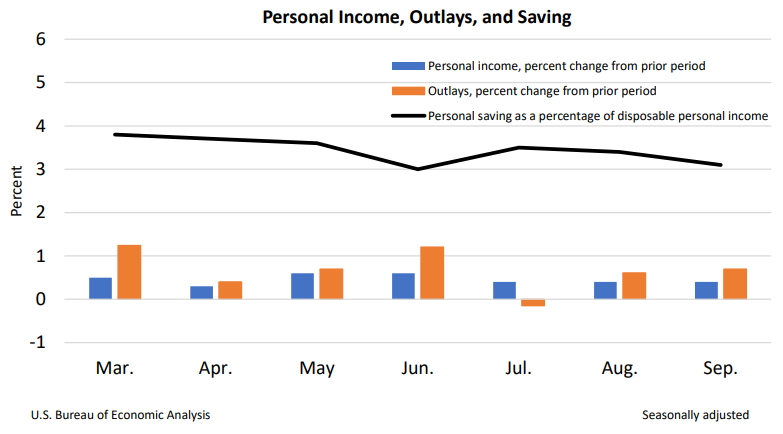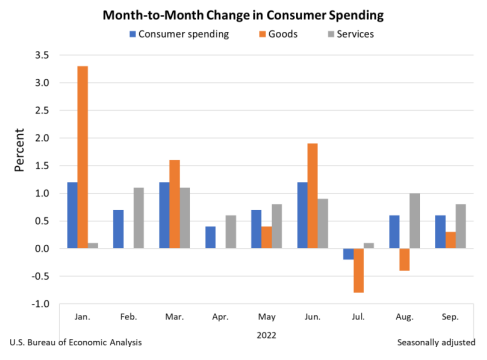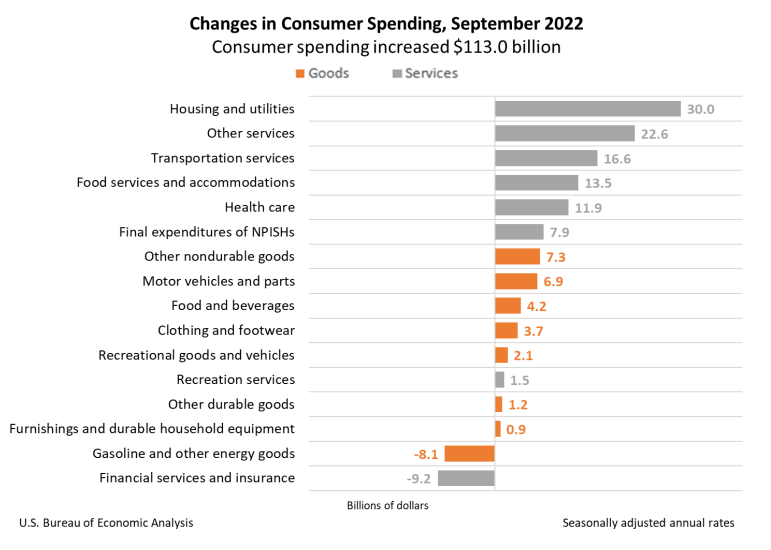Personal income increased $78.9 billion, or 0.4 percent at a monthly rate, while consumer spending increased $113.0 billion, or 0.6 percent, in September. The increase in personal income primarily reflected increases in compensation and personal income receipts on assets. The personal saving rate (that is, personal saving as a percentage of disposable personal income) was 3.1 percent in September, compared with 3.4 percent in August.
Personal income
In September, personal income increased, primarily reflecting increases in compensation and personal income receipts on assets.
- Within compensation, the increase primarily reflected an increase in private wages and salaries, based on data from the Bureau of Labor Statistics (BLS) Current Employment Statistics (CES). The increase reflected increases of $47.7 billion in private services-producing industries and $13.1 billion in goods-producing industries.
- Within personal income receipts on assets, both interest and dividend income increased.
Consumer spending
Personal outlays increased in September, reflecting increases in consumer spending for both services and goods.
- Within services, the largest contributors to the increase were housing and utilities (led by housing), “other” services (led by international travel), and transportation services (led by air transportation), based on Transportation Security Administration data on the number of travelers.
- Within goods, the largest contributors to the increase were “other” nondurable goods (mainly prescription drugs), based on private data, and motor vehicles and parts (led by new motor vehicles). These increases were partly offset by a decrease in gasoline and other energy goods, based on Energy Information Administration data.
PCE price index
The personal consumption expenditures (PCE) price index for September increased 6.2 percent from one year ago, reflecting increases in both goods and services. Energy prices increased 20.3 percent while food prices increased 11.9 percent. Excluding food and energy, the PCE price index for September increased 5.1 percent from one year ago.
Compared to August, the PCE price index increased 0.3 percent. Energy prices decreased 2.4 percent and food prices increased 0.6 percent. Excluding food and energy, the PCE price index increased 0.5 percent from August to September. For a comparison of PCE prices to BLS consumer price indexes, refer to NIPA Table 9.1U. Reconciliation of Percent Change in the CPI with Percent Change in the PCE Price Index.
Real disposable personal income and consumer spending
Real disposable personal income increased less than 0.1 percent in September and real consumer spending increased 0.3 percent; services increased 0.3 percent and goods increased 0.4 percent. Within services, the leading contributors were “other” services (mainly international travel), food services and accommodations, and health care. Within goods, the increase primarily reflected an increase in spending on gasoline and other energy goods.
For more information, read the full release.



